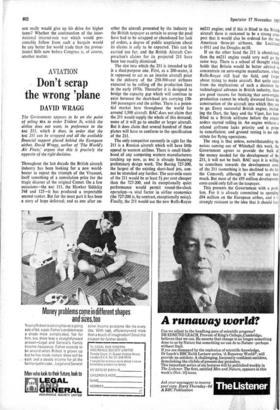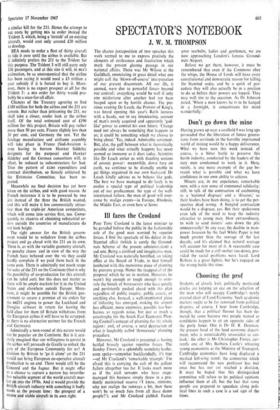Don't scrap the wrong 'plane
AVIATION
DAVID WRAGG
The Government appears to be on the point of telling BEA to order Trident 3s, which the airline does not want, in preference to the BAC 211, which it does, in order that the BAC 211 can be scrapped and all the available financial support placed behind the European airbus. David Wragg, author of 'The World's Air Fleets,' argues that this is precisely the opposite of the right decision.
Throughout the last decade the British aircraft industry has been looking for a new world- beater to repeat the triumph of the Viscount, itself something of a consolation prize for the tragic disaster of the original Comet. On a few occasions—the BAC ill, the Hawker Siddeley 748 and 125—it has produced a respectable second-ranker. But for the most part it has been a story of hope deferred; and as one after an-
other the aircraft presented by the industry to the British taxpayer as certain to scoop the pool have had to be scrapped or abandoned for lack of orders, a degree of public scepticism about its claims is only to be expected. This can be carried too far; and the British Aircraft Cor- poration's claims for its projected 211 have been too readily dismissed.
The slot into which the 211 is intended to fit is a dual-purpose one. First, as a 200-seater, it is supposed to act as an interim aircraft prior to the delivery of the 250-300-seat airbuses expected to be rolling off the production lines in the early 1970s. Thereafter it is designed to bridge the capacity gap which will continue to exist between the short-haul jets carrying 130- 160 passengers and the airbus. There is a poten- tial market here throughout the world for around 1,500 aircraft. BAC does not claim that the 211 would supply the whole of this demand; some of it will go to smaller or larger aircraft. But it does claim that several hundred of these planes will have to conform to the specification of the 211.
The only competitor currently in sight for the 211 is a Russian aircraft which will have little appeal to western airlines. There is small likeli- hood of any competing western manufacturers catching up now, as BAC is already financing preliminary design work. The Boeing 727-200, the largest of the existing short-haul jets, can- not be stretched any further. The seat-mile costs of the 211 would be at least 51- per cent cheaper than the 727-200, and its exceptionally quiet performance would permit round-the-clock operation—a vital factor in airline economics (the 727-200 is, by contrast, exceptionally noisy). Finally, the 211 would use the new Rolls-Royce Ra211 engine; and if this is fitted to the British aircraft there is reckoned to be a strong pros- pect that it would also be ordered for the two American three-jet airbuses, the Lockheed L-1011 and the Douglas Dc10.
If on the other hand the 211 is abandoned, then the RB211 engine could very well go the same way. There is a school of thought which holds that Britain would be better advised to concentrate on aero-engine manufacture, where Rolls-Royce still lead the field, and forget about trying to make aircraft. But quite apart from the implications of such a decision for technological advance in British industry, there are good reasons for thinking that aero-engine production cannot be wholly divorced from the construction of the aircraft into which they are to go. Every successful British engine, includ- ing the Dart, the Spey and the Viper, has been fitted to a British airframe before the export orders started rolling in. An engine without a related airframe lacks priority and is prone to cancellation; and ground testing is no sub- stitute for flying operations.
The snag is that unless, notwithstanding the noises coming out of Whitehall this week, the Government agrees to provide the bulk of the money needed for the development of the 211, it will not be built. BAC says it is willing to contribute towards the development costs of the 211 (something it has declined to do for the Concord), although it will not say how much. But most of the £95 million development costs could only fall on the taxpayer.
This presents the Government with a prob- lem. For it is already committed to spending £94 million on the European airbus, and it i. strongly resistant to the idea that it should foot a similar bill for the 211. Hence the attempt to cut costs by getting BEA to order instead the
Trident 3, which, being a 'stretch' of an existing aircraft, would cost only around £20 million to develop.
BEA needs to order a fleet of thirty aircraft to tide it over until the airbus is available. But it infinitely prefers the 211 to the Trident for this purpose. The Trident 3 will still carry only 136 passengers, and at this size it will, in BEA'S estimation, be so uneconomical that the airline has been saying it would need a 13 million a year subsidy if it is forced to buy it. More- over, there is no export prospect at all for the Trident 3: a BEA order for thirty would pro- bably be a once-for-all affair.
Chances of the Treasury agreeing to find £180 million for both the airbus and the 211 are remote. But rather than jettisoning the 211, we shall take a closer, cooler look at the airbus itself. Of the total estimated cost of £190 million for this project, Britain will pay rather more than 50 per cent, France slightly less than 30 per cent, and Germany the rest. Yet the fuselage manufacture and airframe assembly will take place in France (Sud-Aviation is even having to borrow Hawker Siddeley designers for the purpose) and Hawker Siddeley and the German consortium will, in effect, be reduced to subcontractors for Sod.
Thus the pattern of ELDO expenditure and contract distribution, so fiercely criticised by the Estimates Committee, has been re- peated.
Meanwhile no final decision has yet been taken on the airbus, and with good reason. At
French insistence it is to be powered by two jets instead of the three the British wanted, and this will make it less commercially attrac- tive than the triple-jet American competitors, which will come into service first, too. Conse- quently its chances of obtaining substantial or- ders outside the countries of manufacture do not look bright.
The right answer for the British govern- ment would be to withdraw from the airbus project and go ahead with the 211 on its own.
There is, as with the variable geometry aircraft, no penalty clause, and in view of the way the
French have behaved over the VG they could
hardly complain if we paid them back in the same coin. There is admittedly not much scope for sales of the 211 on the Continent (that is why the possibility of co-production for this aircraft can be ruled out); but this does not matter as there will be ample markets for it in the United States and elsewhere outside Europe. More- over, it might be possible for the , British gov- ernment to secure a promise of us orders for the aa211 engines to power the Lockheed and Douglas airbuses in return for leaving the field clear for them (if Britain withdraws from the European airbus it will have to be scrapped, as there is no alternative partner for the French and Germans).
Admittedly a turn-round of this nature would not be popular on the Continent. But is it seri- ously imagined that our willingness to persist in the airbus will persuade de Gaulle-to unlock the gate of the European Community for us? A decision by Britain to `go it alone' on the 211 would not bring European co-operative aircraft production to an end. There would still be the Concord and the Jaguar. But it might offer Us a chance to capture a narrow but neverthe- less valuable segment of the world aircraft mar- ket oit into the 1970s. And it would provide the Brills% aircraft industry with something it badly needs at the present time: the prospect of a secure and viable aircraft in its Own right.



































 Previous page
Previous page